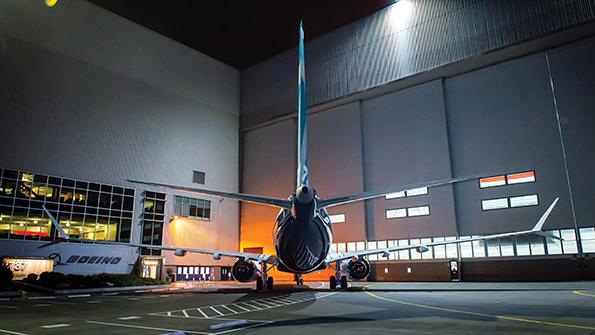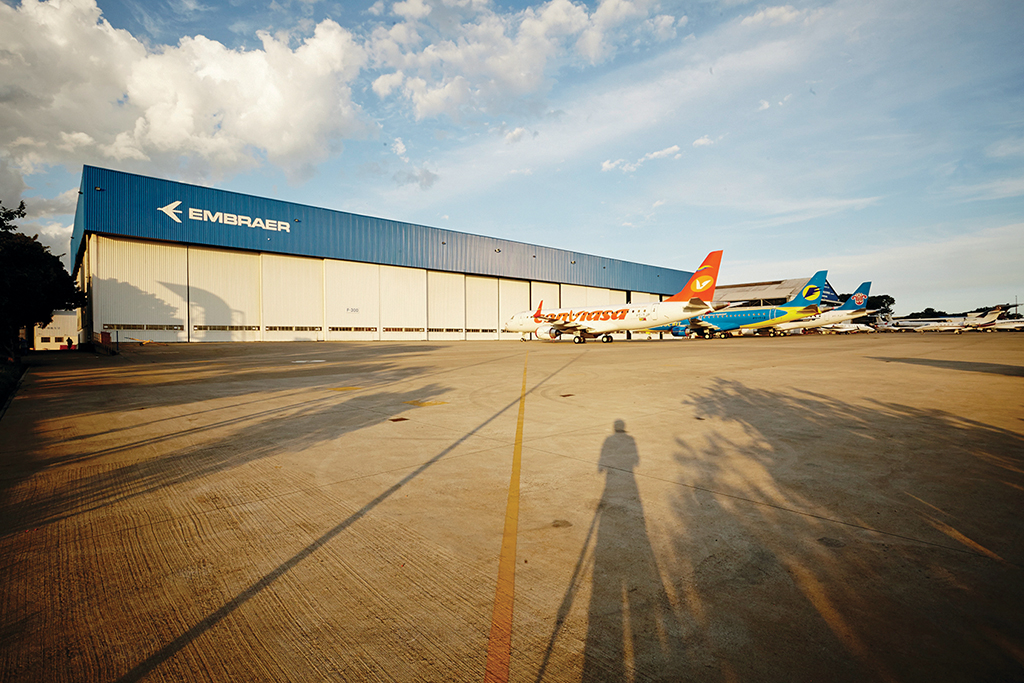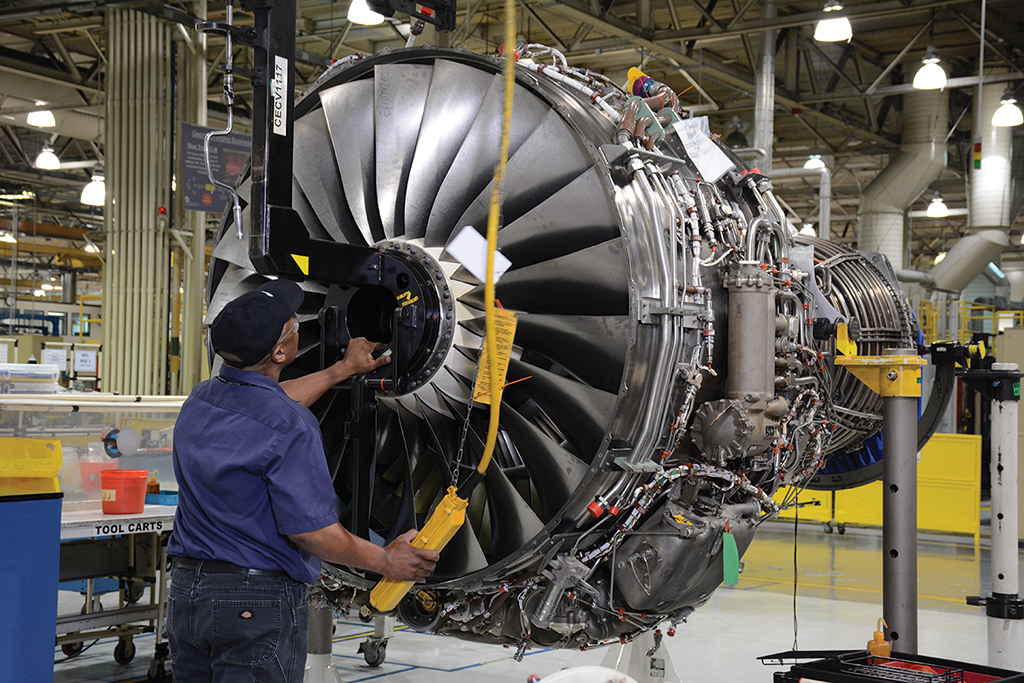As Operators Rebound, OEMs Refocus On Aftermarket Support

The downturn has forced Boeing Global Services to revisit its lofty revenue goals.
Prior to the 2020 global travel downturn, many aftermarket providers were scrambling to keep up with demand. As the industry recovers, now there is a scramble of a different sort. Engine-makers are staffing up to meet rising demand and handle initial waves of new-generation engine overhauls, as well as some lingering teething problems on a few of these platforms. For the major airframe manufacturers, the tasks are somewhat more routine: focusing on supporting the in-service fleet and circling back to pre-pandemic strategies that sought to build revenue through aftermarket services.
Before the downturn, Boeing had massive aspirations for its Boeing Global Services (BGS) business. Launched as a formal business unit in 2017, BGS was tipped to become a $50 billion-a-year business in a decade or so.
Then reality and the pandemic-induced downturn set in. Now the outlook is less lofty, though still ambitious.
“I want all of you to know $50 billion is not in any page or any chart or in any discussion,” Boeing CEO Dave Calhoun said at the company’s November 2022 investor day. “We simply want to make disciplined allocation decisions in a growing market, one that’s very attractive and, in our view, can deliver real value for all of us.”
Boeing’s acknowledgement could be good news for many in the aftermarket services community for several reasons. Among them: The company recognizes that while leveraging its intellectual property (IP) is still a prudent tactic for expanding its services revenue, collaboration must play a major role as well.
“We are being very thoughtful [in] our capital deployment,” BGS President and CEO Stephanie Pope said. “Where we invest, where we can leverage and grow our IP to deliver value and creat[e] different business models within the industry to partner and collaborate where we can’t [is our focus].”
BGS also will need help in supporting its high-growth product lines, such as converting passenger airframes to freighters.
Ironically, Boeing corporate’s pull-down of BGS’ stretch goal comes at a time when the business is poised to take advantage of its strengths. Serving the blossoming freighter market is one example, as is providing parts for a global fleet hungry to keep up with demand. Issues delaying deliveries of new aircraft—including many coming off of Boeing’s own production lines—also bodes well for BGS, as older aircraft stay in service longer.
Then there are the less visible segments of BGS, such as providing software that helps operators become more efficient. Lowering fuel burn and optimizing aircraft tail assignments to fit known events such as upcoming maintenance checks are the kinds of strategies that airlines—desperate to save money and under pressure to reduce their carbon footprint—are poised to embrace.
BGS’s full-year 2022 revenue was $17.6 billion (see chart). While still off of 2019’s peak of $18.4 billion, the business is clearly in growth mode. The revenue split is back to 60% commercial and 40% military—another pre-pandemic benchmark—and the commercial services volume has “recovered to pre-pandemic levels,” the company says.
“We continue to grow,” Calhoun said on the company’s January 2023 earnings call. “We continue to invest so that we are prepared to support our customers as they bring their [fleets] back to where they were before COVID.”

Expanding aftermarket capacity is a big initiative for Embraer as well—to meet robust maintenance demand and to accommodate new projects.
“The industry is booming back so quickly now, and people are flying airplanes so much that they are coming into maintenance faster than they were before, especially because there was pent-up demand during COVID,” says Frank Stevens, Embraer Aircraft vice president for global MRO centers.
Embraer just expanded its aftermarket presence in Sorocaba, Brazil, by leasing a fourth hangar next to its three existing ones. Two are dedicated to executive and defense aircraft—with the private aviation maintenance slots sold out for the next three years. The hangar dedicated to commercial aviation will see four lines of Embraer 190 nose-to-tail maintenance from Aerolineas Argentinas starting in the next two months.
Embraer also opened a maintenance base in Sao Jose dos Campos, where it will perform E190 and E195 cargo conversions. The OEM announced the conversion program in March 2022, and it received the first E190 on Feb. 17. It is starting maintenance on the aircraft and expects to start structural work via a supplemental type certification in the second quarter.
In addition to the maintenance operations expansion in Brazil, “we’re just getting our feet wet with regards to expansion globally because we’re working on a couple different projects right now that will allow us to expand commercial and executive operations,” Stevens says.
In the U.S., its Nashville, Tennessee, maintenance facility is sold out through 2024, and it can only accommodate “one to two more aircraft” at its Macon, Georgia, facility, which will then be sold out through 2024 as well.
While 70% of its aircraft are in North America and are still fairly young—some approaching about a decade—their second phase of life could see them moving to secondary markets. Stevens says Embraer is evaluating the transitions and exploring whether to form joint ventures, add authorized service centers or build its own.
“We’ve got a lot of backing from the company leadership to expand the MRO operation, and we’re going to take advantage of that,” he says.
“Embraer is looking at breaking the mold” of only providing maintenance services for its own aircraft and adding “agnostic capability,” he adds. “So if you have a [Boeing] 737 and an Embraer and you want us to do both, how can we take care of that for you?”
The first priority is expanding capacity for Embraer customers, Stevens notes. “And then after that, it’s: How do we break the mold from what an OEM is? Because in my business, my competitors are not Boeing and Airbus,” he says. Rather, they are independent OEMs, he says, which can work on multiple OEM aircraft types.
Another way Embraer is trying to build capacity is through faster turnaround times. It is exploring digital and paperless options, as well as reviewing “task by task” to tighten delivery times to within hours instead of days. Stevens hopes these efficiencies also will partially offset the tight labor market. With these efficiency gains, Embraer will gain more throughput, which also helps with capacity needs.
Engine OEMs
Engine OEMs face many of the same challenges as they did pre-downturn, with one notable exception. Demand for work on current-generation engines, notably the CFM International Leap and Pratt & Whitney PW1000G geared turbofans, is rising, both as a consequence of the fleet’s steady aging and some lingering reliability problems.

“Over the last six months, the [PW1100G-JM] has experienced diminished service availability, an issue that has been steadily increasing over this period,” Spirit Airlines President and CEO Ted Christie said in unusually candid remarks during a recent earnings call. “This is not just a Spirit issue. Pratt & Whitney continues to struggle to support its worldwide fleet of [A320neo] aircraft as MRO capacity remains constrained and turnaround times for engines in the shop have been nearly three times longer than the historical averages for [previous-generation A320] engines.”
“We have put in place a number of fixes to the combustor, to the No. 3 turbine blade, to other parts of the engine where we’ve seen reliability issues,” said Raytheon CEO Greg Hayes, referring to a series of issues that plagued the PW1000G family following its 2016 entry into service. “We’re still not where we need to be. And as a result of that, our customers are not particularly happy with the fact that we can’t get engines to them in time because of the large numbers that are coming in for all of these retrofits.”
Hayes, speaking on a late-February earnings call, acknowledged that Raytheon business unit Pratt likely will be dealing with the issue “all year long.”
He acknowledges that while issues such as parts availability are causing problems, the OEMs have exacerbated current problems through a lack of foresight.
“We blame everything on supply chain because it’s easy,” Hayes said at a February Barclays investor event. “The fact is, we missed some of the big changes that were happening in the marketplace around lead times and around raw material availability, and we were late to recognize some of those expanded lead times. We didn’t get things [ordered] as quickly as we [could]. We had designs that were not completely mature that we were releasing into the supply chain that had to have parts reworked.”
Lower-than-expected reliability metrics for new engines combined with new-aircraft delivery delays linked to both engine suppliers and broader supply chain issues mean airlines must keep more older airframes and engines flying longer. This is creating some strain for engine suppliers as they adjust their aftermarket transition plans.
Take the International Aero Engines V2500. A narrowbody fleet workhorse for years, the powerplant was supposed to be moving into a downward trend in terms of MRO demand by now. But trends are changing because of supply chain issues for other powerplants and surging narrowbody demand.
Pratt, an IAE consortium partner and primary V2500 aftermarket support provider, sees shop visits for the venerable powerplant rising to the mid-800s this year from about 700 in 2022.
“Three years ago, we thought the [V2500] was kind of going to be petering out, [but] retirements have been almost nonexistent in that fleet,” Hayes said. “There are still about 6,000 engines out there, which is double the number of [PW1000G geared turbofan] engines in service today. That aftermarket continues to be very strong.”

Meanwhile, GE Aerospace is confident that it will meet sharply rising demand from both airframe manufacturers and the aftermarket in 2023.
“We do expect new units to grow more rapidly than services,” CEO Larry Culp said on the company’s fourth-quarter earnings call in late January.
CFM, the GE-Safran joint venture, delivered 1,136 Leap-family engines in 2022, GE reported. CFM Leap-family engine deliveries are forecast to increase “about 50%” in 2023, or about 1,700 units, according to GE projections, Culp said.
The uptick is part of a ramp-up to meet rising production rates on the all-CFM-powered Boeing 737 MAX program as well as the Airbus A320neo family, which splits its engines between CFM’s Leap and Pratt’s PW1000G geared turbofan.
Supply chain constraints have been challenging both engine-makers, contributing to lower-than-projected delivery totals from the two major airframers in 2022.
GE Aerospace expects its full-year 2023 OEM business revenue to grow 20%, while services will increase 15-20%. “We’re laser-focused on supporting airframers, airlines and lessors as they ramp [up] post-pandemic,” Culp said. “Today that means providing stability and predictability for our customers—keeping our mature fleet flying and growing our new fleet.”
That will require addressing both the Leap’s growing aftermarket demands as well as a CFM56 overhaul surge that has been slowly shifting to the right due to the downturn’s ramifications. GE Aerospace added 1,300 people across its network of overhaul shops in 2022 and is gearing up for a 20% increase in engine shop visits this year, says GE Aerospace Materials General Manager Horacio Repetto.
“Supply is growing at a very rapid rate, but demand is outpacing it,” he says. “We’re going to have to work closely together in the next year or two [or more] to be well-coordinated on how we meet that demand. It’s not about when the supply chain gets healthy. It’s about when it catches up to demand.”
If GE’s spare-parts sales figures are any indication, the supply chain has its work cut out for it. One of the company’s key metrics is its spare-parts rate, loosely defined as the daily value of spares shipped or used in the company’s shops. The pre-downturn high was $31 million in 2019, and the trough, in 2017, was $17.8 million. The full-year 2022 rate was $26.9 million—not quite back to 2019’s high-water mark, but headed that way quickly (see chart on page MRO11).
Rolls-Royce is bullish about the aftermarket going forward. In its 2022 full-year financial results, the engine OEM reported 1,044 total shop visits, versus 953 in 2021. There were 248 large engine major shop visits in 2022, comprised of Trent engines, versus 208 visits two years ago.
This year, commercial engine maintenance is expected to see a further spike. “For 2023, we expect between 1,200 and 1,300 total shop visits with a step-up in large engine shop visits as higher flying-hours activity converts into increased demand for aftermarket services,” Panos Kakoullis, Rolls-Royce’s chief financial officer, stated as the company’s annual results were revealed in late February. However, Rolls is wary of the impact on aftermarket recovery prospects of supply chain challenges and external factors such as rising inflation.
The company reported delivery of 44 large spare engines in 2022—higher than usual and eight more than the prior year—representing 23% of total deliveries. “We expect spare-engine volumes to remain at a similar level overall in 2023 and 2024,” Kakoullis says.
Predictive Maintenance
While keeping the in-service fleet flying is the main focus for both OEMs and their customers, the two sides have other, less critical priorities. One area in which operators are eager to see advances is predictive maintenance. All the OEMs have such programs, and many operators supplement these with their own tailored programs. While these efforts are progressing, airlines—under immense pressure to keep aircraft moving and avoid unanticipated interruptions, want more.
Take engine-condition monitoring. The practice of using data snapshots to flag imminent issues is well understood, but it leaves holes.
“Snapshot data will always have a place in trend monitoring, but we can go further,” American Airlines Vice President for Technical Services Mark Miner said at the recent Aviation Week AeroEngines Americas event. “This trend monitoring is limited by the narrow scope of that data set, which in turn limits the analysis that can be done. These days, we have access to more expanded engine performance data that we have yet to fully leverage.”
Engine core performance is critical to overall powerplant reliability. But, Miner said, most issues today do not involve the core, and when they do, current trend monitoring often flags them.
However, line replaceable units (LRU) are a different story.
“LRU performance is where we need to place our focus to drive improved engine reliability,” he said. The key is using operator data and OEM data models in tandem.
“Operators are relying on OEMs to step up in support of this important area of engine reliability as they develop their own data-driven programs for predictive maintenance,” Miner said. “This is a critical area where we can partner.”
Such pleas are not going unnoticed.
“How much data is coming off our equipment, and what is a very, very large installed base?” Raytheon Chief Operating Officer Chris Calio asked at a recent Citi Global investor conference, pointing to Pratt’s engines and Collins’ suite of products specifically. “How do we harness that data? How do we create solutions for our customers using that data? How do we do better predictive maintenance and get out ahead of issues? There’s a whole suite of solutions given all the data. . . . I would say it would be another macro investment area.”


